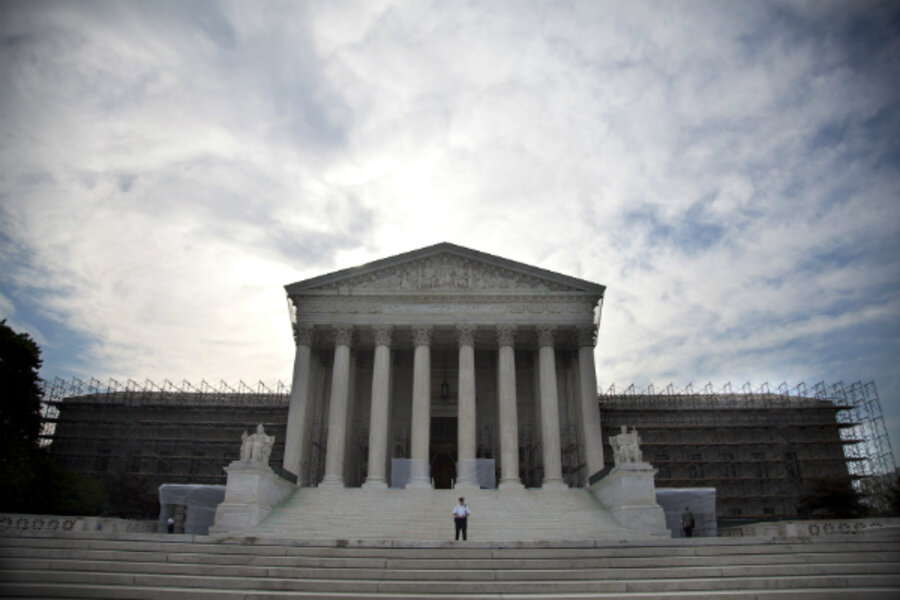'Elite' Supreme Court sides with science and juveniles
Loading...
Did the Supreme Court embrace an “elite vision” on Monday when it struck down state laws mandating life imprisonment for juvenile murderers?
That’s what Justice Samuel Alito said, in an angry dissent from the bench. By invalidating such laws, Mr. Alito fumed, the court’s 5-4 majority assumed that it knew better than the 28 state legislatures that have authorized mandatory life sentences without the possibility of parole for killers younger than 18.
But the court’s majority really does know better. And there’s a simple reason for that: It relied on science – in particular, the science of adolescent brain development.
Science seems to have taken quite a beating as of late. Consider this year’s GOP presidential sweepstakes, in which exactly one candidate – Jon Huntsman – was willing to acknowledge man-made climate change. The rest of the field insisted that the phenomenon still lacked sufficient scientific evidence.
But at least the candidates admitted that science matters. By disputing the science of climate change, indeed, they implicitly acknowledged that public policy should be based on accurate scientific research and knowledge.
Not so Justice Alito or Chief Justice John Roberts, who also dissented in the mandatory-sentencing decision. Both judges simply ignored the mounting scientific evidence that adolescents lack the same reasoning power and impulse control as adults. They didn’t say the science was ambiguous, or wrong; instead, they said it was irrelevant. And that’s worse.
After all, brain research was invoked in the court’s 2005 decision invalidating the death penalty for people under 18. The research also figured in its 2010 ruling striking down life sentences for juveniles convicted of crimes other than murder.
And since those cases, as the court’s majority noted on Monday, evidence about delayed adolescent brain development has become even stronger. “‘It is increasingly clear that adolescent brains are not yet fully mature in regions and systems related to higher-order executive functions such as impulse control, planning ahead, and risk avoidance,” the court wrote, quoting a brief by the American Psychological Association.
If that’s true, then it’s cruel for states – and the federal government – to mandate that every adolescent murderer gets jailed for life. Alas, it’s not unusual. More than 2,500 people are currently serving life without parole for murders they committed before they were 18. And about 2,100 of them were convicted in states where these sentences were mandatory.
If the science of brain development made it unconstitutional to put juveniles to death – or to put them away for life, for crimes short of murder – than why wouldn’t it also invalidate life sentences for murder itself? The court’s dissenting minority didn’t say. Rather, it ruled that it could not interfere with a law simply because the measure flouts scientific knowledge.
“Perhaps science and policy suggest society should show greater mercy to young killers, giving them a greater chance to reform themselves at the risk that they will kill again,” Chief Justice Roberts wrote. “But that is not our decision to make.”
That sentence strikes me as cruel, in and of itself. Science might have discovered new facts about the nature – and the limits – of adolescent judgment and self-control, with enormous implications for calculating criminal responsibility. But if state lawmakers want to ignore these discoveries, Mr. Roberts says, the court won’t get in the way.
And nothing in Monday’s decision will prevent a judge from sending a juvenile to prison for life. The ruling simply bars mandatory life-sentence laws, which prevent courts from taking into account all the extenuating evidence – including, of course, evidence from science.
That brings us back to Justice Alito, who railed about the “elite vision” of the court’s majority. He’s right, but there’s nothing wrong with it. Science is itself a kind of elitism, insofar as it privileges rigorous experimentation and testing over cant, guesswork, and propaganda. And we need more of it, not less.
Over a century ago, in 1908, Louis Brandeis defended a state minimum-hours law for working women by presenting the Supreme Court with a 113-page brief of evidence about the dangerous effect of long working hours on female health. Later, when he joined the court himself, Brandeis became its leading tribune for applying our best scientific knowledge to our toughest legal dilemmas.
“A lawyer who has not studied economics and sociology is very apt to become a public enemy,” Brandeis wrote in 1935, in his now-classic text The Living Law.
Today, we might add psychology to Brandeis’s list of required disciplines. But don’t tell that to Justices Alito and Roberts. Remember, they didn’t voice objections to the scientific evidence; they simply dismissed it. Thank heavens that the court’s slender majority thought better of what we know, and of why it matters. Somewhere, Louis Brandeis is smiling.
Jonathan Zimmerman teaches history and education at New York University. He is the author of “Small Wonder: The Little Red Schoolhouse in History and Memory” (Yale University Press).







